Lower Limbs
Lower Limb Surgery is a specialised field of orthopaedic surgery that addresses a wide range of conditions affecting the bones, joints, ligaments, and tendons in the hip and knee. The goal is to diagnose and treat problems that cause pain, limit movement, or affect a person's ability to perform daily activities.
A key principle in orthopaedic care is to first explore all non-surgical options. Many hip and knee problems can be managed successfully with conservative treatments, which may include:
- Physiotherapy: A physiotherapist can provide targeted exercises to strengthen muscles, improve flexibility, and increase joint stability.
- Targeted Injections: Corticosteroid or hyaluronic acid injections can be used to reduce inflammation and provide temporary pain relief.
- Walking Aids: Using a walking stick, crutches, or a walking frame can reduce stress on the joint and help with mobility.
- Activity Modifications: Adjusting lifestyle or work activities to avoid movements that cause pain can help manage symptoms.
When these non-surgical approaches are no longer effective, or for conditions that are too severe for them, surgical intervention may be recommended. Surgical procedures for the hip and knee can relieve pain, improve mobility, or restore function lost due to injury, arthritis, or congenital deformities. Common procedures include hip replacement, knee replacement, and arthroscopic (keyhole) surgery.
Trauma
Hip Fracture
A hip fracture is a break in the upper part of the thigh bone (femur), near the hip joint. It is a serious injury that can be life-threatening. Hip fractures are most common in older adults, often due to a fall, especially in people with osteoporosis (a condition that weakens bones).
What are the Symptoms?
If you have a hip fracture, you will experience:
- Severe pain in your hip or groin.
- Inability to put weight on your leg.
- The affected leg may appear shorter than the other and may be turned outwards.
- Inability to move your leg.
What to Do
A hip fracture is a medical emergency. If you or someone you know has a suspected hip fracture:
- Call for an ambulance immediately.
- Do not try to move the person.
- Keep the person warm and as comfortable as possible while you wait for help to arrive.
Treatment
Almost all hip fractures require surgery. The type of surgery depends on where the bone is broken and how severe the fracture is.
- Internal Fixation: If the fracture is stable, the surgeon may use screws, plates, or rods to hold the broken pieces of bone together.
- Partial or Total Hip Replacement: If the bone is badly broken or has a poor blood supply, the surgeon may replace the damaged parts of the hip with an artificial joint.
Recovery
Recovery from a hip fracture is a long process that often involves a stay in the hospital followed by rehabilitation.
- Rehabilitation: A physiotherapist will work with you to help you regain your strength and ability to walk. It is important to begin these exercises as soon as your surgeon gives the go-ahead.
- Mobility: Many people need a walking frame or crutches for a period of time after surgery.
- Long-Term Care: A hip fracture can have a major impact on a person's independence. Rehabilitation can help people return to their homes, but some may require ongoing care.
It is important to follow your care team's advice to ensure the best possible recovery and to prevent future falls.
Kneecap (Patella) Dislocation
A patellar dislocation is an injury where your kneecap (patella) slips out of its groove on the front of your thigh bone (femur). It can be a very painful and alarming injury, as the kneecap may be visibly out of place. This most often happens when the knee twists awkwardly, such as during sports.
What are the Symptoms?
The most common signs of a patellar dislocation are:
- Sudden, severe pain in the knee.
- The knee may look deformed, with the kneecap visibly out of its normal position.
- You may hear or feel a "pop" at the time of injury.
- Inability to straighten your leg or put any weight on it.
- Swelling around the knee joint.
What to Do
If you think you have dislocated your kneecap, you should:
- Seek immediate medical attention. Do not try to put the kneecap back in place yourself, as this could cause further damage.
- Support the leg gently in a straight position.
- Apply a cold compress (like an ice pack wrapped in a towel) to the area to help with pain and swelling.
Treatment and Recovery
A doctor will perform a "closed reduction" to gently manoeuvre the kneecap back into its correct position. You will be given medication to help with pain and muscle relaxation.
- Immobilisation: You will likely need to wear a brace or splint for a few weeks to keep the knee straight and allow the ligaments to heal.
- Physiotherapy: Once the initial pain and swelling have gone down, a physiotherapist will guide you through exercises to strengthen the muscles around the knee, especially the quadriceps. This is crucial for preventing the kneecap from dislocating again.
- Surgery: In some cases, surgery may be needed. This is usually for people who have had multiple dislocations or where the first dislocation caused significant damage to the cartilage or ligaments.
With proper care and rehabilitation, most people make a full recovery. It is very important to follow your physiotherapist's plan to reduce the risk of future dislocations.
Knee Ligament Injury
Ligaments are strong, flexible bands of fibrous tissue that connect bones to other bones. The knee joint has four main ligaments that provide stability. Injuries often happen during sports when the knee twists awkwardly, is hit from the side, or overextends.
Symptoms
The symptoms of a ligament injury vary depending on which ligament is damaged and how severe the injury is. Common signs include:
- A "popping" sound or sensation at the time of injury.
- Pain on the inside, outside, or in the centre of the knee.
- Swelling and tenderness around the joint.
- A feeling of instability or that the knee will give way.
- Difficulty putting weight on the leg.
Treatment and Recovery
The treatment for a knee ligament injury depends on its severity.
- Non-Surgical Treatment: Mild to moderate ligament sprains (grades I and II) can often heal with rest, ice, and elevation. A knee brace can provide support, and physiotherapy is crucial to strengthen the muscles around the knee and restore movement.
- Surgical Treatment: A complete tear of a ligament (grade III), especially the ACL, may require surgery to reconstruct the ligament. This is often recommended for people who want to return to high-impact sports. The surgeon will use a graft (a piece of tendon from another part of your body) to create a new ligament.
Recovery from a knee ligament injury, with or without surgery, can be a long process. It's vital to follow a structured rehabilitation programme to regain full strength and stability and to prevent the injury from happening again.
Disorder
Osteoarthritis
Osteoarthritis (OA) is the most common form of arthritis. It's a "wear and tear" condition where the protective cartilage that cushions the ends of your bones gradually breaks down. This causes the bones to rub against each other, leading to pain, stiffness, and loss of movement. It can affect any joint, but it is most common in the weight-bearing joints of the hip and knee.
Symptoms
The main symptoms of hip and knee osteoarthritis are:
- Pain: This is often a deep, aching pain in the joint. It may be worse during or after activity and can make it difficult to sleep.
- Stiffness: The joint may feel stiff after you've been sitting or lying down for a while, especially in the morning.
- Limited Movement: It can become difficult to bend or straighten your knee or to move your hip.
- Swelling: The joint may be swollen and tender to touch.
- Grinding Sensation: You may feel a grinding, clicking, or cracking sensation when you move the joint.
Treatment and Management
While there's no cure for osteoarthritis, there are many ways to manage the symptoms and slow its progression.
- Lifestyle Changes: Losing weight can significantly reduce the stress on your hip and knee joints.
- Physiotherapy: A physiotherapist can provide exercises to strengthen the muscles around the joint, improve flexibility, and reduce pain.
- Pain Relief: Over-the-counter pain relievers and anti-inflammatory medications can help. Your doctor may also recommend targeted injections.
- Walking Aids: Using a walking stick or a walking frame can take pressure off the joint and help with mobility.
- Surgery: If conservative treatments are no longer effective and your quality of life is severely affected, your doctor may discuss surgery, such as a hip replacement or knee replacement, to relieve pain and restore function.
Versus Arthritis: Osteoarthritis
Lateral Hip Pain
Greater Trochanteric Pain Syndrome (GTPS) is a common condition that causes pain and tenderness on the outer side of the hip. This area is known as the greater trochanter, which is the bony bump on the side of your thigh bone (femur). The pain can also spread down the outside of your thigh.
It's often caused by inflammation of the tendons (tendinopathy) and the fluid-filled sac (bursa) that lie over this bony bump. The condition used to be called trochanteric bursitis, but it's now known that the problem often involves the surrounding tendons as well.
Symptoms
The main symptoms of GTPS are:
- Pain and tenderness on the outer hip, which can be sharp at first and become a dull ache.
- Pain that gets worse with activity, such as walking, running, or climbing stairs.
- Pain that is worse at night and can make it difficult to sleep, especially if you lie on the affected side.
- Discomfort when standing for a long time.
Treatment and Management
Most cases of GTPS can be successfully treated without surgery. The goal is to reduce pain and inflammation and to strengthen the surrounding muscles.
- Activity Modification: Avoid activities that worsen the pain, such as running or walking up hills.
- Pain Relief: Over-the-counter anti-inflammatory medications like ibuprofen can help.
- Physiotherapy: A physiotherapist can provide targeted exercises to stretch and strengthen the muscles around the hip and improve stability. This is a very important part of treatment.
- Injections: Your doctor may recommend a steroid injection into the area to reduce inflammation and provide pain relief.
- Surgery: Surgery is rare and is only considered for severe cases that haven't responded to other treatments. It may involve removing the inflamed bursa or repairing torn tendons.
Recovery can take a few months, and it's important to be patient and consistent with your exercises to ensure a good long-term outcome.
Surgery
Hip Replacement
A total hip replacement, also known as hip arthroplasty, is a major surgical procedure to replace a damaged hip joint with an artificial one. The hip is a "ball and socket" joint. During the surgery, the damaged ball at the top of the thigh bone (femur) and the worn-out socket in the pelvis are removed and replaced with a new metal or ceramic ball and a plastic or ceramic socket.
Knee Replacement
A knee replacement, also known as knee arthroplasty, is a surgical procedure to replace a damaged knee joint with an artificial one made of metal and plastic. The goal of the surgery is to relieve pain and restore a better range of movement.
The most common reason for a knee replacement is severe pain and disability caused by osteoarthritis (wear and tear of the joint). It is also performed for other types of arthritis, such as rheumatoid arthritis, or to treat certain knee injuries. The surgery is usually recommended when conservative treatments, such as physiotherapy and pain relief, no longer provide enough relief.
You can click on the icons below to find out more about problem in specific area.






















